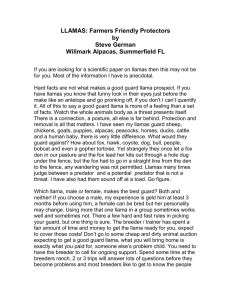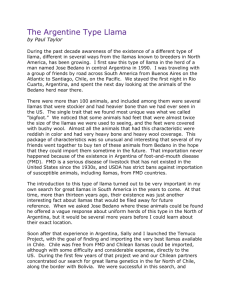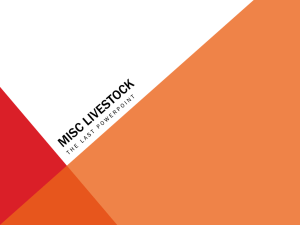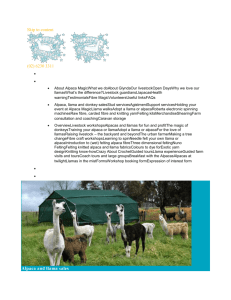Llamas 101 - Wool and Flax Llama Farm
advertisement
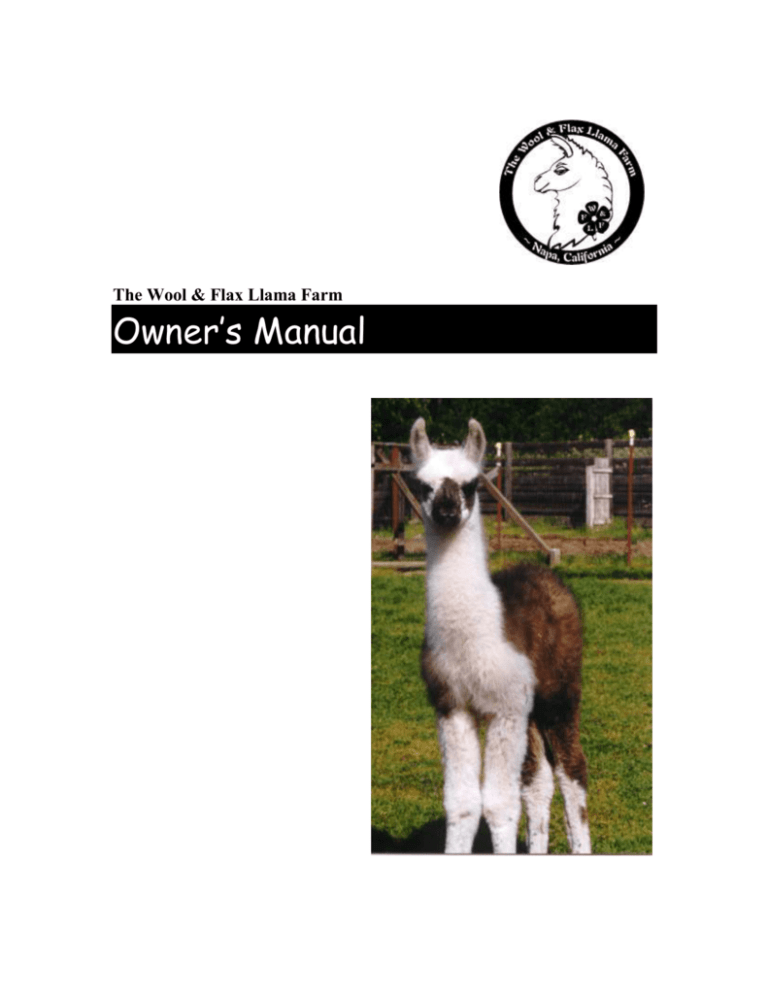
The Wool & Flax Llama Farm Owner’s Manual L l a m a O w T a b l e n e o f r s M a n u a l C o n t e n t s General Information Introduction 2 Llamas 101 3 Llama Facts 6 Training 8 Vaccinations, Worming & Coccidia 9 Birthing 11 Guard Llamas 12 Llamas & Fire 13 Common Myths 14 Why Llamas? 2 …………………… 16 The W o o l & F l a x L l a m a F a r m Llamas are my secret friends, …mystical, we go walking together. We …magical, talk without saying a word. ...wonderful. We take turns playing follow- They are my… -the-leader and hide-n-seek. I silent companions. love the llamas and they love me! …………………… 3 L l a Llama m a O w n e r s M a n u a l (yá-ma or lá-ma) Llamas are known as the “Trucks of the Andes”. They are bred primarily as beasts of burden. Llamas are members of the Lama family of Camelids and are native to South America. Other Lamas are the domesticated Alpaca, bred for its fine fiber, the wild guanaco, and the rare vicuña. Their only natural predator is the Mountain Lion (Cougar or Puma). Lamas and Camels are cousins. Llamas are used for showing, packing, cart driving, guards for sheep and goats, fiber (wool) production, pets and breeding. An adult Llama can carry 60-80 pounds 8-10 miles per day. Their curiosity and quick learning ability make them easy and fun to train. Their gestation period is 11-12 months and they rarely have twins. The baby Llamas, known as crias, weight 18-36 pounds at birth. They are usually up and around within the first hour. For the first three months they gain almost a pound a day. Most mother Llamas wean their crias by six months of age. Llamas are browsers like goats. Once weaned, they usually thrive on a low protein diet of grasses. Occasionally their diets are supplemented with grains and minerals if their normal feed is very deficient in these essential nutrients. Because their digestive systems are so efficient “hot” feeds such as alfalfa tend to make them fat. On the trail, Llamas do nicely on native vegetation supplemented with 1 cup of grain a day. Llamas are less expensive to feed than a medium size dog. Llamas are very social animals. Because of that, most experts insist that new owners buy at least two. A lone Llama may become depressed and die. Llamas don’t usually require an elaborate shelter. A lean-to providing minimal shelter from the wind and protection of the feed from rain is usually sufficient. Many areas allow up to 10 Llamas per acre. Prices for Llamas vary due to location, breeding, confirmation, training and disposition among other traits. On the West Coast, the price for a quality, registered, trained and gelded 18-month-old male starts around $450. Most breeders have package deals and are willing to finance purchases. Though Llama specific products are usually not sold at the local pet store, there are a number of mail order firms featuring quality Llama products. The practically odorless Llama “pellets” make an excellent soil amendment. They are low in nitrogen and don’t require extensive composting. In fact you can apply fresh pellets directly to many plants. “Harvesting” of the Llama pellets is easy, because Llamas “go” in only a few spots. Llamas communicate primarily through body language (watch their ears). They do have a wide range of vocalizations when a simple twitch of an ear isn’t enough. They hum to their crias, growl at one another, “orgle” during mating and they also have a high pitched scream which is an alarm call. Although they do spit at each other, they seldom spit at people unless teased. They are very gentle and clean animals. They are a joy to raise. 4 …………………… The W o o l & F l a x L l a m a F a r m Llamas 101 Lon Hanke (Past CAL-ILA President) Llamas are wonderful, intelligent creatures that are very satisfying to own. In the last few years a number of slogans have been enshrined on bumper stickers by the Llama community: Enrich your life - Discover Llamas, Llamas - A Lifestyle Investment, Take a Llama to Lunch and I love my Llama. For me, all are appropriate and perhaps understate their case. Llamas truly are a great joy to be with! THE FIRST TWO LLAMAS One of the first questions that a potential llama purchaser considers is how many do I need and what sex should they be. In order of importance the answers are as follows: Llamas are herd animals who are very gregarious and need social contact with other llamas. You definitely need more than one llama. Llamas have been kept singly but it is not fair to the animal and the probability of success is dramatically reduced. Llamas can be kept with other grazing animals, but another llama is vastly better. Most experienced breeders will not sell a newcomer a llama that will be housed singly. Two gelded males are the simplest option and the least expensive. The possibility of problems is reduced. The two males can also make a nice pack string for a couple. Groups of gelded males can normally be kept together successfully. There are a few exceptions. An older dominant male can create problems for a younger or less dominant male. Injuries with males are more likely to occur if there is a great difference in size. Having said that two males are the least risky way of starting, I must tell you that we started with mostly females. A group of females generally can be kept together without any problems. …………………… 5 L l a m a O w n e r s M a n u a l Intact males can be kept together in some conditions. Younger males up to 14 or 20 months do very well. After that the playing or rough housing can get serious. For the first 3 to 6 months with llamas, it is best to stay with a tried and true combination of llamas. After that, a newcomer's learning curve will be sufficient to manage a herd with various combinations. OBSERVATION & STOICISM In real estate it is said that location, location and location is all important. It is my opinion that in llama herd and medical management it is observation, observation and observation that is all important. Llamas are very stoic and can be very sick before they show any obvious signs. Stoicism is part of their delightful personality. Remember, in humans we value the trait highly. But the stoicism of llamas requires that we pay careful attention to them in order to detect small changes in behavior that may indicate medical needs. Besides observing llamas and their antics is delightful - it is part of the joy of llamas. Llamas are creatures of habit, and if you notice that their routine has changed it is a good indication that something may be wrong. FENCING Another basic consideration when stating with llamas is fencing. Five or five and a half foot height is probably the best. Llamas will usually respect a lower fence. The notable exceptions are males, when challenging each other, and a llama that is scared - such as being chased by a dog. There are a variety of types of fencing. Perimeter fencing should be constructed with thoughts of keeping predators out. Coyotes and the neighborhood dogs can cause a significant amount of damage. 1. No climb is a heavy woven wire fence with small openings and is probably the best fencing available. It is also a bit more expensive. The 2" x 4" openings are small enough that there is very little that gets through or caught in the fence. No climb is a good choice in intensely used areas such as paddocks or where maximum predator control is desired on a perimeter fence. When stretched tightly it forms an impressively strong barrier. No Climb is very effective at keeping dogs out. 2. Field fence is a lighter duty woven wire fence that has larger openings, in various combinations up to 6 inches square. The wires are a lighter gauge than the no climb material. The material cost is about 3% to 4% the cost of no climb, which roughly reflects the amount of steel in each. Field fence is used successfully when a less than a "bullet proof' fence is acceptable. Llamas can get their heads caught in the openings when trying to get to the grass on the other side. Field fencing with a tighter weave on the bottom can be effective in keeping predators out. 3. New Zealand or high tensile fence is a different system consisting of 7 to 15 strands of smooth wire run individually. The material cost is still lower, because there is less wire. The installation cost is somewhat greater because there are multiple wires to handle and the integrity of the system is much more dependent on good tensioning which demands more elaborate end post systems and tensioners. The higher installation costs are reduces on long runs. High tensile fence frequently has alternate wires electrified. Electric systems have both advantages and disadvantages. They are powerful but they require more maintenance. High tensile is more appropriate on long lesser used runs and is not as viable a choice on short runs and in more intensely used paddocks. Aesthetics can be tricky - A tall high tensile fence with a lot of wire can look a little like a fortress. A common application is to use electrified high tensile fence between fields with intact males. Non-electrified high tensile fencing is not much of a deterrent to predators. 4. Wooden fencing with three (or four) rails is more expensive but is very attractive. Small crias can walk through the rails unless there is a wire between the boards. Curiosity gets them through the fence. They then stand on the other side wondering why there is a fence between them and the rest of the herd. They are cute. The maintenance on a wood fence can be significant (outrageous?), especially if it is white rather than brown. Predators can usually get though a rail fence rather easily. 5. Vinyl three rail fence is more expensive than wood but doesn't need painting. 6 …………………… The W o o l & F l a x L l a m a F a r m 6. Panels made of welded tubing can be used a temporary fencing or to create corrals. Cattle panels can be used but are much heavier than necessary for llamas. Lightweight panels designed specifically for llamas have been available for several years. They are offered in several llama product catalogs. 7. Barbed wire is not preferred for constructing llama fences. However, many llama ranches that had other livestock have existing barbed wire fences. They are satisfactory if a little caution is used. The danger of injury to the llama, potential fiber damage from rubbing on the fence and the fact that predators can easily get under the fence make this a good candidate to replace with a more appropriate fence. Fencing costs vary significantly but generally are in the range of $3 to $7 per linear foot, installed. OTHER MATERIALS The following items were all originally written for our internal use to help organize the ranch. Then they evolved and were given to our customers to help them get started with llamas. The ILA Llamas Facts sheet is excellently written and a great short introduction to llamas. We use it all the time for the public and newcomers. ILA has a series of 10 superb brochures on basic llama subjects. They include Medical Management, Housing and Fencing, Wool, Packing Feeding and others. A Llama Training Curriculum is a quick road map for training. It assumes that the reader has some understanding of llama psychology and behavior. The Vaccinations, Worming and Coccidia procedures sheet is designed to help new people get organized in the area of llama management that can be a little confusing. A significant caveat is that most new llama ranches initially only will need the vaccination procedures and a very small portion of the information on worming and coccidia. As always, any Herd Medicine Management Program should be reviewed by your veterinarian to insure it meets the needs of your animals and your locale. The Birthing Checklist is written at a very basic level and assumes that the reader has little experience with animal birthing. …………………… 7 L l a m a O w n e r s M a n u a l LLAMA FACTS YESTERDAY AND TODAY Lamas (single "L"), which include the llama (double "LL"), alpaca, guanaco and the endangered vicuna, are members of the camel (camelid) family. Originating in the Central Plains of North America about 4O million years ago, the lama predecessors migrated to South America around 2.5 million years ago. Its cousin, the camel, relocated to the Middle East and other regions of the world. The end of the Ice Age 10,000 to 12,000 years ago marked the extinction of the camelid in North America. Llamas were domesticated from the guanacos of the Andean highlands of Peru 5,000 to 6,000 years ago and are among the world's oldest domestic animals. While primarily a beast of burden for the native herdsmen, llamas also provided them with meat, wool, hide for shelter, manure pellets for fuel, and became sacrificial offerings to their gods. Today there are an estimated 7 million llamas and alpacas in South America. Based on information provided by the International Lama Registry, in the United States and Canada there's an estimated 74,000 to 77,000 llamas, 5,300-5,700 alpacas, and 250 to 300 guanacos. Llamas have international appeal, with countries such as New Zealand augmenting their fiber industry with llama and alpaca wool. As in ancient times, the llama today is important to the agricultural economy of the remote highlands of Argentina, Bolivia, Chili, and Peru. In North America the llama and alpaca industry is recognized as a viable agricultural entity. PHYSICAL FACTS Life Span: About 15 to 29 years Height: 36" to 47" at the shoulder, 5'to 6'5" at the head Weight: 250 to 450 pounds Average Gestation: 350 days Color: A llama may be solid, spotted, or marked in a wide variety of patterns, with wool colors ranging from white to black and many shades of gray, beige, brown red, and roan in between. Reproduction, Birth and Babies: Females are first bred at 16 to 24 months of age. Llamas do not have a heat cycle; they are induced ovulators (ovulation occurring 24 to 36 hours after breeding). Llamas can be bred at any time of the year. A single baby ("cria") is usually delivered from a standing mother, normally without assistance. Most births occur during daylight hours, which is better for the cria and most certainly more convenient for the llama owners. Twinning is a rare occurrence. Normal birth weights are between 20 to 35 pounds and the cria usually stands and nurses within 90 minutes. Depending upon the cria's size and the mother's condition, the baby is weaned at 4 to 6 months. Health and Basic Medical Needs: Because their ancestors evolved in the harsh environment of the Andean highlands, North American llama owners have found them to be generally easy to care for. 'Me recommended primary care of yearly vaccinations, routine worming, and regular toenail trimming help llamas remain hardy and healthy. FREQUENTLY ASKED QUESTIONS What are they used for? Contemporary North American llamas are bred and raised for packing, wool production, cart pulling, animal facilitated therapy, companion animals, exhibition in shows, parades and fair, and guardians of other livestock such as sheep. The llama is becoming increasingly popular as a project animal for 4-H, Scouts, FFA and other youth activities. For the outdoor enthusiast and athlete, there are numerous activities and competitive events that team up the llama and his owner. Llamas are great family fun! Can you use their wool? Grease-free and lightweight, llama wool is warm and luxurious. A valuable commodity sought after by fiber artists, such as weavers and spinners, the wool is a marketable product for llama owners. 8 …………………… The W o o l & F l a x L l a m a F a r m Are they intelligent? Yes, which is why llamas can quickly learn to accept a halter, follow on a lead, load in and out of a vehicle, or carry a pack, Are they good pack animals? Sure-footed and agile, most llamas are excellent packers and can carry an average of 80poundsor25%oftheirbodyweight. Their two-toed foot with its leathery pad gives the llama a low environmental impact equivalent to that of a considerate hiker's athletic shoe. Their ability to browse lessens their intrusion on the native vegetation, which is one of the reasons llamas are gaining in popularity with environmentally conscious users and managers of our public lands. Historically llamas have carried packs for man; however, some llamas have been trained to carry a small child. What do they eat? Llamas are modified ruminants with a three-compartment stomach. Like cattle and sheep, they chew their cud. Because of a relatively low protein requirement and an efficient digestive system, they can be kept on a variety of suitable pastures or hay, with the supplemental of recommended vitamins, minerals and salt A llama costs significantly less to feed than other comparable-sized animals. What is their personality like? Because they are highly sociable herd animals, llamas need the companionship of other llamas. Independent yet shy, llamas are gentle and curious. Their generally calm nature and common sense make a trained llama easy for anyone to handle and an excellent choice for a child's pet and companion. What sounds do they make? Llamas communicate by humming. They also express themselves through a series of ear, body, and tail postures. On rare occasions they will alert their companions and human keepers with a distinctive alarm call to the presence of unfamiliar dogs or other creatures which they perceive as threats. Llamas warn each other off by growling and making a clicking sound. During breeding males make a distinctive orgling sound. When fighting some llamas make a load growling noise. Do they spit? Llamas will spit at other llamas in order to establish the pecking order within the group, to ward off an unwanted suitor, or to say, "Stop it!" A llama who has been mishandled, feels abused, or threatened may occasionally spit at humans. Usually before spitting a llama will pin their ears back and lift their chins in a warning gesture. Are they registered? Yes. The International Lama Registry issues registration certificates and maintains a current database. Two identification processes gaining prevalence within the llama industry are blood typing and micro chipping. These efforts not only help protect the llama gene pool but also assure new buyers that llamas are a wise and pleasurable investment. Recently DNA profiling has become common. How much do they cost? Costs vary from region to region throughout the United States and Canada. As a rule of thumb, you should expect pet males to be the lowest priced, sometimes as low as $200. Trained packers can range from $500 to $2,500. Young, stud quality males will be higher than pet males, with mature stud quality males generally higher yet. Weanling females are generally (but not always) less expensive than bred females. The price structure for females, as well as that for stud quality males, can vary greatly. The bottom end of the female price range is about $1,500 to $4,000 and up, depending upon quality, bloodlines and other factors. Contact a local breeder for more information. …………………… 9 L l a m a O w n e r s M a n u a l A Llama Training Curriculum A good time to start llama training is just after weaning. The first few days after weaning a llama is especially dependent. Their attentiveness can be constructively utilized for training. It is my feeling that a beginning person should start training this time. Experienced llama trainers can begin when the llama is about two months old, with excellent results. Novice trainers risk having the llama bond to humans by training before weaning age. Training can be done in approximately the following order: DESENSITIZATION Start at the withers, then move up the back of neck and down the back, then around neck and around body. The head and legs are the most sensitive and should be done last. Legs and feet can be done with wands, then hands and blower. HALTERING After the head is desensitized and llama is confident of people start introducing the halter slowly and carefully. Let the llama wear the halter for some time before using the lead. LEADING Lead first for short distances in the stall (using a short lead for safety). This stage is critical. If the llama bucks the training needs to be slowed down. Then lead into new areas - the paddock, barn and eventually around the ranch. Introduce to different surfaces, i.e., gravel, concrete, exposed aggregate and the red gravel, etc. OBSTACLES After the llama is comfortable being lead, introduce them to various obstacles, roughly in order of difficulty. From the stalls; to the barn; out to visit the other pastures to see different llamas across the fence; going through low trees and bushes in the yard; off and on the low part of the loading dock then gradually increase the height to a jump; into buildings - the shop & chicken coop; into enclosed spaces - the chute, trailer, scale & van; and up and down the front stairs to the house. ADDITIONAL DESENSITIZATION Additional desensitization should be done at this stage to insure that the llama is comfortable with toenail cutting, the blower, having his mouth handled and medical procedures. PACKING and PUBLIC RELATIONS Selected llamas should be taught to carry a pack. Males and females can both make good packers. Personality and willingness are more important than wool length. Obstacles such as the creek below the pond and a walk on the plank can be used. Any llama that will be around people should be worked with more for public relations use. Usually llamas need to be 4 or 5 years old before they are mature enough to stand quietly while being surrounded by crowns of people. The level of trust developed between llama and handler makes a big difference in how the llama will react to different situations. GUARD LLAMAS There is a common misperception that you can put a llama in a field with sheep and goats and it will protect them. To be successful llamas must first be introduced to different livestock. It is best if you can have the llama share a paddock, field and barn stalls with the same type of livestock as you plan on having it guard. Even a week of experience will go a long way to insuring the success of a guard llama. All guard animals should be halter/lead trained and be able to accept medical treatment. 10 …………………… The W o o l & F l a x L l a m a F a r m Vaccinations, Worming & Coccidia VACCINATION SCHEDULES CDT & COVEXIN 8 We use CDT (also know as 3-Way) for clostridial diseases. We give CDT to crias at 8 and 12 weeks after birth, and then annually to all adults. We also give CDT to pregnant females 6 to 8 weeks before delivery. Some other farms use a sheep product, Covexin 8. This 8-Way product includes protection against some diseases that llamas are not susceptible to. Covexin may cause miscarriages when used with pregnant females. The dosage for both is 6 cc per llama. For crias the dose is divided into two 2.5 cc shots, one on each side. A 50ml bottle has 10 doses - keep refrigerated - about $6. LEPTO 5 We use NOVALEP 5 for leptospirosis and related diseases. The schedule of administration is the same as for Covexin and CDT. In the Sierra Foothills, Lcpto 5 is used only with irrigated pasture. Lepto type diseases are generally related to cattle operations or where flood irrigation is common. The dosage is 2 cc for an adult or a cria. A 20-ml bottle has 10 doses - keep refrigerated - about $5. RABIES Rabies shots are given annually. IMRAB-3 is used frequently. In California, and about half the states, rabies vaccinations are regulated by the state and may be given only by a veterinarian. Llamas are very curious and can be bitten by rabid animals. WORMING Our worming schedule; Twice a year for the whole herd, in the spring when everything starts to grow and in the fall after the rains start. We usually do NOT worm females that are close to term. On an as needed basis for an individual or group. For llamas leaving the ranch, a few days before departure. For llamas coming on the ranch (if not already wormed). IVOMEC for cattle (brown bottle) and IVOMEC F (which also treats liver flukes) are injectables that can be used for llamas. The active ingredient is Ivermectin. The dosage is 1 ml per 110 pounds of body weight, (i.e., 2 ml for 220 pounds, 3 for 330 pounds and 4 for 440 pounds). A 50-ml bottle has about 12 to 20 doses - no refrigeration needed - about $33. …………………… 11 L l a m a O w n e r s M a n u a l IVOMEC POUR ON for cattle is also successful. It is more expensive. We use it to reduce the stress of administration. It is also a very convenient choice when restraint is difficult or if no one is able to give injections. So llamas dislike the sensation of the alcohol base evaporating. IVOMEC PASTE for horses can also be used for llamas. We use it most commonly, as we prefer oral administration. They come in a plastic dose syringe that is calibrated for body weight. A 25-gram syringe deworms 1,100 pounds of animal weight (2 to 5 llama dosages) - about $4. PANACUR and SAFE-GUARD are also paste wormers for horses. Both are 10% fenbendazole made by the same company. They can be used as an alternative to Ivermectin. Before alternating wormers, please consult your veterinarian. They come in a plastic dose syringe that is calibrated for body weight. A 25-gram syringe deworms 1,100 pounds of animal weight (2 to 5 llama dosages) - about $4. COCCIDIA Coccidia are intestinal parasites. Coccidiosis can be treated with ALBON (sulfadimethoxine) a bolus or liquid or CORID (amprolium) a soluble powder or liquid. The liquids are easier to administer. One gallon is about $50. Albon and Corid are administered orally with a dose syringe for treatment of individuals or in drinking water for herd treatment. When dosing a 300 pound individual, use Albon at 2 oz the first day and 1 oz for 3 or 4 more days. Adjust the dose proportionally by body weight. DECCOX (decoquinate) is a good coccidia preventative for herd treatment. A powder, it can be mixed with feed or granular salt or offered in a commercially prepared pellet or crumble. In general, we treat coccidiosis aggressively because it can be difficult to control and can reoccur easily. If we suspect worms or Coccidia in a pasture, we have samples analyzed. If necessary, fecal samples can be extracted directly from the suspect animal using a latex examination glove. Any llama that does not have well formed beans is treated immediately. INJECTIONS The injections for Covexin 8, CDT, Lepto 5 and Ivermectin injectable are given subcutaneously with a 2, 2.5, 3 or 5 ml disposable syringe using a 20 gauge, 1 inch needle. Covexin and CDT settle easily and need to be shaken vigorously. Ivermectin is viscous and a little difficult to pass through a needle. It is somewhat painful to the llama because it stings. GEOGRAPHY & PREFERENCE Vaccinations, worming and Coccidia treatments vary considerably with geographic location and somewhat with density, cleanliness, fencing, irrigation, medical skills and personal preference. These are the procedures we have elected to use on irrigated pasture in our area. Other medicines and techniques can be used successfully. Please consult a local veterinarian or experienced llama ranches for recommendations for your area and conditions. 12 …………………… The W o o l & F l a x L l a m a F a r m Llama Birthing Checklist This is written at a basic level for people unfamiliar with birthing. It is designed to help people gain the confidence to be able to assist llama births. Some of the signs of imminent birth are an enlarged profile or a barrel look, a swollen vulva, an elongated vulva, developed nipples (like a Hershey's kiss), an enlarged udder, humming, general discomfort, a concerned facial expression, and lying down and standing interchangeably in an attempt to get comfortable. Llamas may show some of these signs up to several weeks before birth, show some signs but not others, show the signs in greatly differing degrees or just deliver without any clear signals. Within a half-hour after the water breaks, the head and two front feet should emerge first. Any other presentation is abnormal. If there is no progress within an hour, suspect trouble and call the vet. During birthing, check for breathing! If needed, remove the membrane and mucous (if any) from the baby's nose. If the mother objects to this procedure, or any other human intervention, omit the procedure. When in doubt - do no interfere! Iodine the navel right after the baby is born. Remove the membrane from the baby and dry with a towel. Crias do not thermo-regulate well for an hour or two after birth. Protect the baby from cold and wind. A hair dryer or a heat lamp can be used to warm the baby. Protect both the cria and mother from extreme heat in the summer (over 90 or 100) with shade and a fan in the barn. Iodine the navel again after the baby is mostly dry. Be careful not to damage the umbilical cord near the base - it can be fatal. Weigh the baby after things have settled down, in about an hour. Watch carefully to see that the baby is nursing and getting colostrum within the first few hours of birth. If not, call the vet. The placenta usually passes within 4 hours, although 8 or up to 24 hours is acceptable. Examine it to make sure that it is in a single piece and none was left in the uterus. Save it in a heavy plastic bag in a refrigerator for a few days in case it is needed for diagnostic work. If possible, check to see that the baby's meconium passes in about the first half day or day. …………………… 13 L l a m a O w n e r s M a n u a l Qualifying a Llama for Guardian for Sheep by Alvin Bean and Lance Hardcastle, East Fork Llamas, Marshall, NC 28753 Our program for selecting, training, and placing guard llamas is just beginning, however we will share what we have done and what has worked or failed to work for us. Our main goal is to breed and train pack llamas, but not all llamas are physically or psychologically suited to commercial packing. Those that are not are evaluated for other uses, i.e. wool, pets, driving, or guards. Our llamas are kept with a few sheep and goats and most of them guard quite naturally without any help. We bring our dogs with us to tend to the chores. One dog is a husky-shepherd cross that looks like a wolf and moves like a coyote. She is definitely interested in pursuing the sheep and goats, and circles the pastures and paddocks in a menacing manner. The behaviors we look for in the llamas in order of guard capability are: 1. watching the dog 2. alarm calling 3. placing themselves between the dog and the sheep and goats 4. pursuing the dog slowly 5. charging at the dog 6. leading the goats and sheep to the barn and then pursuing the dog. We think that some llamas may have guard potential yet not display it due to being immature, or due to having a low position in the pecking order of the herd. If we think a llama could be a guard, but is not displaying these behaviors for these reasons, we try to encourage and evaluate further in the following way. We place the llama with the sheep and an experienced guard to serve as a role model. Within a week he should begin to show guarding behaviors. The absence of other guards who are "taking care of it" encourages the apprentice llama to take a stronger lead. The apprentice llama will sometimes take the role of herding the sheep into the barn, working in tandem with the other one who goes after the dog. The next step is to remove the role model llama, and place the apprentice in a smaller paddock [approximately 300 square feet] to encourage more bonding with the sheep. If the paddock is too small, the llama may become frightened of the sheep running into his legs [we have seen this happen in a smaller catch pen]. The llama should become more aggressive toward the dog, which is encouraged to circle outside the paddock. If the llama progresses to approaching the dog, the dog is brought into the paddock. Here there are several options including having both the dog and the llama on lead and rewarding the llama for following after the dog. The dog is muzzled as an extra safety feature. Ultimately, we like to see the llama get in between the sheep and the dog, lead the sheep to the barn, and chase the dog under the fence. The area is small enough that we are able to intervene at any time, but we have not had to since we trained the dog to come to an athletic whistle. If the llama does not do his job, and the sheep begin to run, the whistle is very effective in interrupting her "chase" focus and bringing her back to us. We haven't had a llama become too aggressive to the dog. This dog, however, respects the llamas, and retreats as soon as they show assertiveness [much like coyotes are reported to do.] We think the worst part of this program is the stress that the sheep endure, just seeing the dog around as well as potentially being threatened by her. We have a large Tunis ram though, who is not as frightened of the dog as the ewes are but will also permit some chase in a somewhat playful fashion. He has been and will maybe be a better choice in these efforts. We would like to emphasize that the PERSONALITIES of all the training animals involved [dog, experienced guard, sheep, goats, etc.] are crucial in avoiding undue stress to the animals. In our placement of guard llamas, we offer a money back guarantee if the llama in question does not bond with the sheep or fails to guard. Llamas have myriad uses and if one unfit for heavy work does not show guard 14 …………………… The W o o l & F l a x L l a m a F a r m BEWARE OF FIRE by Shane & Tammie Eckhardt potential, it can be trained to be a pet or performance show animal. In our sales contract, we state that llamas cannot defend themselves against dog packs or cougars and may be killed. We stress this verbally also. Some people believe they want a young llama and can train it themselves. This very well may be true, but we recommend to a new llama owner or one that is less familiar with animals to buy a couple of trained geldings. We say this for three reasons: 1. 2. 3. A trained llama will be a useful llama and one easy to take care of A useful llama is good for the llama industry A trained, useful llama will not be returned. Our efforts at East Fork Llamas from a breeding standpoint are to provide affordable, trained llamas that are as conformationally correct as possible. We place them in situations for which they are suited and will be happy and healthy as well as providing their new owners with an animal that they can successfully take care of and feel comfortable with. Reprinted from: Llama Association of the Mid-Atlantic States January -February 1998 A few months ago we sold a couple of llamas to a lady, one was a younger male and one was a three year old gelding. She called me a few days later and wanted to know what the deal was with llamas and fire? I really didn't know what to say because this is not one of your commonly asked new owner’s questions. It seems she was cleaning up a lot that she had put the llamas in and decided to burn some sticks and leaves that she had raked up at one end of the lot. A few minutes after the fire got going the gelding came running from the far end of the lot as fast as he could run, got down on his knees and tried to smash out the fire with his chest. At this point the new owner along with being scared to death was thinking she had just purchased the craziest animal on earth. While trying to hold a new llama, getting him off his knees, and extinguish flaming wool, she couldn't believe what she was seeing. Lucky for both animal and owner the llama did not receive any skin damage, just some extra really curly wool on his chest. It was a scary but valuable lesson for a new llama owner to say the least. I talked to several owners and I could not find anyone who’d had a similar experience. I started to think this might be an isolated incident until I decided to clean out the tack and feed room in our barn. I had cleaned out a bunch of old feed sacks and put them in the corner of the lot to burn them. There were about a half dozen one to two year old male llamas that came to see what I was doing as usual. I lit the sacks on fire and stepped back in the barn to get a shovel full of straw off the feed room floor to throw on the fire. When I stepped back out of the barn, what did I find ... the fire department in action! Two of the older males were on their knees trying to smash out the fire. Same as before, no major damage, just some singed wool. OK, I know the National Forest Service uses some llamas for packing but I'm at this point starting to think about their usefulness for stomping out forest fires [Ha!]. Since this has happened, we keep a really close eye on the animals whether it be burning sacks, camp fires while packing, or whatever. We now pen all the animals up if we do any burning. They will still stand in the smoke and try to get as close as possible to the fire. I don't know whether we just have a crazy bunch here on the farm or llamas are really firemen at heart. In either case, we learned the hard way. Reprinted from the March, 1998 issue of Golden Plains Llama Association’s newsletter, GPLA NEWS. …………………… 15 L l a m a O w n e r s M a n u a l COMMON LLAMA MYTHS EXPOSED! ESSENTIAL FACTS YOU NEED TO KNOW BEFORE BUYING LLAMAS MYTH: I’ve heard Llamas spit! FACT: Llamas do spit ... at each other to establish food dominance and herd pecking order. Pregnant female llamas spit at breeding males to tell them to "buzz off'. Llamas spit as one of their few forms of self-defense. Snakes and dogs bite, cats scratch and skunks spray in self-defense. Llama spit semi-digested hay, not nearly as bad as bites, scratches or skunk spray. When llamas spit at humans it is usually a last resort. They are telling the human to stop doing whatever they are doing to the llama. MYTH: Folks say that Llamas are exotic animals, like ostriches and emus. FACT: Llamas are Camelids, cousins to Camels and Alpacas. Llamas are classified as livestock in California. In South America llamas are used for pack transportation and alpacas are fiber producers. Poor economic conditions and scarce resources necessitate that the South Americans also use llamas and alpacas for meat. In the USA we don’t eat our pets or companion animals. MYTH: Don’t just the rich or eccentric own Llamas for amusement? FACT: There are over 100,000 llamas in the country owned by teachers, doctors, nurses, police officers, firefighters, farmers, truck drivers, computer experts, insurance salespersons, college students, average families, the young and old. Llamas have many uses. They are wonderful pets, companions, great 4H project animals, excellent packers for outdoors enthusiast and hunters, fine fiber producers for spinners and weavers, organic lawnmowers for vegetation control, compost producers for gardeners, reliable guardians for sheep and goats, cart pullers and competition show animals. Regardless of their function, llamas are fantastic just for loving. MYTH: I know that Llamas are too expensive to purchase as a pet. A registered dog is cheaper. FACT: Llama prices vary depending on animal age, bloodlines, sex, training and reproductive use. Females are generally more expensive than males. High quality breeding stock is more expensive than a pet non-breeder. Pet gelded male prices start around $400. Breeding quality animals start around $1,000 for males and $1,500 for young females depending on bloodlines and training. Comparatively registered dog prices can vary from $400 to the thousands. Here are some simple tips for smart llama purchases: 1. 2. 3. 4. Know what your plans are for llamas and buy the type of animals that match your plans. Only buy registered llamas; make sure you get the ILR registration as part of the sales agreement. Only buy llamas that have had training (a minimum of halter and lead training). Make sure you can catch, halter, lead and handle them. Buy llamas from reputable breeders who will provide follow up support. MYTH: I’ve seen ads selling llamas for $200 or less in the newspaper. Couldn’t I breed these and sell the babies and make money? FACT: Yes, you’ll occasionally see llamas for sale at bargain basement prices. But beware, you really do get what you pay for! These cheap llamas may be someone else’s problem and can bring you nothing but disappointment. Llamas MUST BE REGISTERED (with the International LAMA Registry) to be bred, shown, or have any sale value for themselves or their offspring. Often cheap sale llamas are not registered and not minimally halter or lead trained. Untrained animals can be difficult to manage and could accidentally injure someone in their panic to get away from you. MYTH: I can't raise llamas, I have no livestock experience. FACT: Llamas are very easy keepers, but all new owners need education in the llama basics of general management, health care and training. The two best ways of obtaining these essentials is to purchase llamas from reputable breeders and to join a llama organization. Even the "greenest city slicker" can become a competent and knowledgeable llama owner in a short time with the support of other llama owners, breeders and organizations like LANA and CAL-ILA (sponsor of the llama show at the California State Fair). 16 …………………… The W o o l & F l a x L l a m a F a r m MYTH: I hear llamas need big fancy ranch set-ups. FACT: Actually, two llamas can live comfortably on as little as ¼ acre. The living set up is simple. They need 4 to 5 foot high non-barbed wire fencing (depending on the mix of females and intact males), a fresh water source and shelter from wind, rain and snow and shade from the summer heat. A simple 3-sided shelter or roofed pole structure may be adequate. Llamas graze on pasture grass. Grass hay is used for additional feed if there is inadequate pasture for grazing. Most llamas are given supplements of llama pellets and selenium minerals. Work with your local veterinarian to develop an individualized feeding regiment for your llama. MYTH: I’ve heard that Llamas are too expensive to feed and care for. FACT: Llamas are cheaper to feed than a horse or a large dog. Grass hay is $7.50 to $10 per bale. A horse will eat a bale of hay in 3 days; a llama will eat the same bale in 9 days. A 40-lb bag of llama pellets is around $8 to $10. Most llamas are fed a cup of pellets or less daily. Routine care for healthy, non-breeding llamas consist of yearly shots, worming, occasional toenail clipping and simple body shearing in the spring for heat control. MYTH: I’ve been told that it's best to buy a very young baby, bottle-feed it and bond it to humans. FACT: ABSOLUTELY NOT! This is a guarantee for tragedy for all involved. Baby llamas need to stay with mom for up to 6 months for nutrition and to learn normal llama socialization. Babies that bond with humans do not develop normal behaviors or a clear concept of the difference between llamas and humans. While it’s cute to have a baby run to you, jump, frolic and play like a puppy when it is small, that same llama will one day be 300+lbs and won’t understand why it can't jump up and play like it did as a baby. This is especially serious in male llamas as they mature. You, the long time object of affection, now become a breeding prospect. The sweet, loving, over socialized, fluffy baby boy will become a dangerous, unpredictable-breeding machine. This perilous and inappropriate behavior is virtually uncorrectable. The only solution is to destroy the llama. Because of inappropriate human bonding your llama will be condemned to die. BABY LLAMAS NEED TO BE RAISED AND SOCIALIZED BY THEIR MOMS, humans come later! MYTH: They say the long wool llama breed is better to have. FACT: Unlike dogs, horses, goats, etc., llamas have no "breed" distinction. A llama is a llama. Wool types and country of origin distinguish llamas. Wool classifications are short, medium and long wool. Llama countries of origin distinctions are North American, Canadian, Bolivian, Chilean, and Peruvian. Out-cross is a term for llamas with bloodlines from another country other than USA. Llamas born in the USA are considered "outcrosses" if they were bred from parents from another country. Bloodlines, temperament, training and most importantly confirmation are measures of "value" in llamas. The most important thing to remember in valuing llamas is appropriately matching your end purpose or goals with the right llama. MYTH: I want to buy just ONE. FACT: Llamas are herd animals and MUST NOT BE KEPT AS A SINGLE ANIMAL. It’s similar to being the only human on Mars. Sometimes llamas do well with sheep or goats as companions. MYTH: I can't have llamas because I don't have a horse trailer or a truck to pull it with. FACT: Actually many people with llamas don't transport their llamas in trailers. Llamas are very smart animals and can be taught to load and travel in a van or pick up truck bed with stock side panels. …………………… 17 L l a m a O w n e r s M a n u a l Why Llamas? Llamas are clean and intelligent. They make outstanding pets and companions. There are fewer than 110,000 in North America. Llamas are classified as livestock (in some areas.) Llamas are quiet, peaceful animals and make a soft humming sound to communicate. The Crias! (Babies) Llamas come in a variety of colors; white black, gray, red and any combination of these base colors. Llamas are easy to raise, can be handled by anyone and are safe around children and seniors. Llamas are extremely hardy and adaptable to most climates, altitudes and conditions. Llamas get along well with goats, sheep, donkeys, horses, cats and the family dog. Llama adults weigh 250 to 450 pounds. They live 20 to 25 years. Llamas require little space. 1/4 of an acre is fine for two llamas and 5 foot high field fencing is adequate. The Crias! Llamas only eat 4 to 6 pounds of hay per day and require no special diet. Llamas are usually first bred at 18 to 24 months of age. Their gestation period averages 11½ months. Llamas are easily transported in a pick-up, van or trailer. They usually lie down in transit. Llamas don’t bark, bite, dig or have fleas. The Crias! Llamas can be trained to pull carts and carry packs. They produce fine fiber for spinning. Llama shows and competitions can promote a single llama or an entire herd. Llamas may qualify for certain tax advantages and are excellent for an income producing retirement program. The Crias! Why NOT Llamas?!? 18 …………………… The W o o l & F l a x L l a m a F a r m Barney & Bev McClung The Wool & Flax Llama Farm 1188 Olive Hill Lane Napa, CA 94558-2110 707 255-4971 house 707 255-2621 office 707 257-1396 fax barney@napallama.com bevm@napallama.com Web site www.napallama.com …………………… 19



